George Wale, 1840 – ca. 1903
by Brian Stevenson
last updated May, 2017
George Wale designed many improvements for microscopes and other apparatus, and held numerous patents. His revolutionary mechanism for inclining a microscope, the “Wale” limb, was widely copied by manufacturers on both sides of the Atlantic. He was also renowned for high-quality photographic lenses and for an innovative magic lantern projector that can be used with liquid specimens.

Figure 1.
George Wale’s “New Working” microscope, featuring his innovative pivoting mechanism (“Wale” limb). This was described in an 1879 advertisement, “This Microscope has just been brought out by Mr. Geo. Wale, whose reputation as a maker of fine stands is so well known. It embodies several new and important features, foremost among which is the method of hanging the body, so that it may be made to incline at any angle. The method now in general use for this purpose changes the position of the centre of gravity of the instrument, and renders the microscope more or less unsteady. The new method avoids this difficulty, and at the same time furnishes a secure and convenient means of clamping the body at any position - a point of considerable importance, when the instrument is used for some purposes. The stage is of a new construction, very thin, so as to admit the greatest obliquity in the illumination of objects, and with clips which move round it, thus giving many of the advantages of a rotary stage. The clips may be easily and quickly removed, so as to leave a clear stage, and they may also be so applied as to hold the slide against the under side of the stage, when very oblique light is required for resolving difficult test objects. There are two means of adjusting for focus, a coarse movement by means of a well-made rack and pinion, and a fine movement, in which the entire body is moved by what is generally called a ‘micrometer’ screw, acting on a lever. The latter movement has this great advantage, that it does not change the distance between the eye-piece and the objective (as is the case with most of the English fine movements), and consequently does not vary the magnifying power of the instrument - an important point in making delicate micrometric measurements. The diaphragm is of the iris pattern, a form which is generally acknowledged to be the best, but which has hitherto been very costly, those usually supplied being sold for $16. This iris diaphragm is a new form, which, with several other features of this stand, has been patented by Mr. Wale. It may be easily and quickly applied or removed. The New Working Microscope is of substantial make, elegant design, and thoroughly good workmanship. It has the Society screw; drawtube, with Society screw at lower end for receiving long focus objectives, analyzing prism, etc.; plane and concave mirrors, the distance of which from the object may be varied; two Eye-pieces; 2-3 and 1-5 Objectives of Wale's Histological Series. The 1-5 easily and clearly resolves the P. angulatum with light of a very slight degree of obliquity. This Microscope, with draw-tube pulled out, and the body inclined, as shown in the figure, stands 13 1/2 inches high; the draw-tube pulls out so as to give the standard length of body, 10 inches. When placed in a vertical position, with the draw-tube pushed in, the instrument stands only 10 1/2 inches high, so that it can be used comfortably on an ordinary table. This is a great convenience in the rapid examination of liquids. It is very complete in all its appointments, is capable of receiving and doing justice to any accessories, and is contained in a handsome black walnut box, with brass handle, lock and key. It is equal to all the ordinary requirements of any physician, student or naturalist. Price - With Accessories, as above described - $35.00”. Images adapted, with permission, for educational, nonprofit purposes from http://www.antique-microscopes.com/photos/George_Wale_Working_microscope.htm
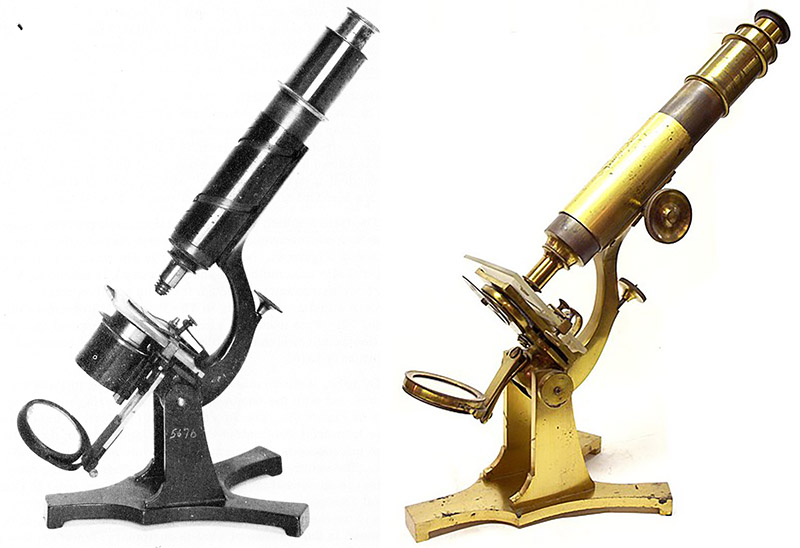
Figure 2.
(Left) One of only two known surviving instruments from Wale’s ca. 1870-1874 partnership of Hawkins & Wale. The coarse focus of the microscope is achieved by rotation of the inner, brass body tube, which slides a knob along a spiral groove in the outer, iron body. (Right) A microscope sold by Benjamin Pike's Sons, with a base / limb that is essentially the same as the Hawkins & Wale instrument. Prior to working with Hawkins, George Wale had a partnership with Richard Morrison, who had previously been employed by Pike, which probably explains the similarities between the two microscopes. Adapted for nonprofit, educational purposes from (left) D.L. Padgitt’s “A Short History of the Early American Microscopes” (also shown in Hansen, et al. “The Billings Microscope Collection of the Medical Museum Armed Forces Institute of Pathology”, image 104) and (right) http://www.antique-microscopes.com/photos/Pikes_Son_microscope.htm.
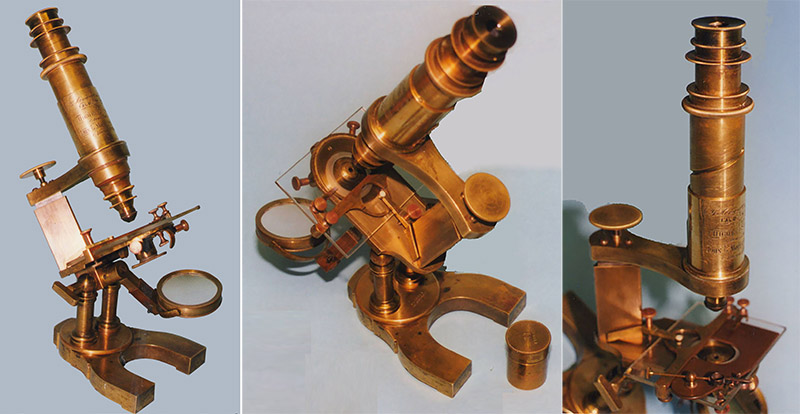
Figure 3.
Wale microscope, engraved with a gift presentation date of March 1877, and incorporating features from his June, 1876 patent. It also features the spiral coarse focus of the Hawkins & Wale instrument shown in Figure 2, and a rotating base that gives maximal stability when used in upright or reclined positions. Wale showed this model at the 1876 International Exposition in Philadelphia: “George Wale's new student's microscope is exhibited by the Stevens Institute of Technology. This is indeed an educational microscope, and not a burlesque on the claim of the instrument to educational value. It is a small and compact stand, of the Continental style, with horse-shoe base and low stage, of most substantial workmanship, adopting the Zentmayer glass stage, and introducing an original coarse adjustment by means of a sliding tube with the addition of a pin moving in an oblique slot and giving a rapid and very steady and safe adjustment by means of a screwing movement, and an iris diaphragm capable of being used after the Continental plan close to the object slide, consisting of a thin split tube whose blades are overlapped and gradually closed by being screwed up into a dome-shaped cavity in the bottom of the stage plate. The instrument is furnished with Wale's excellent lenses”. Adapted for nonprofit, educational purposes from http://www.microscope-antiques.com/waleprizemicro.html
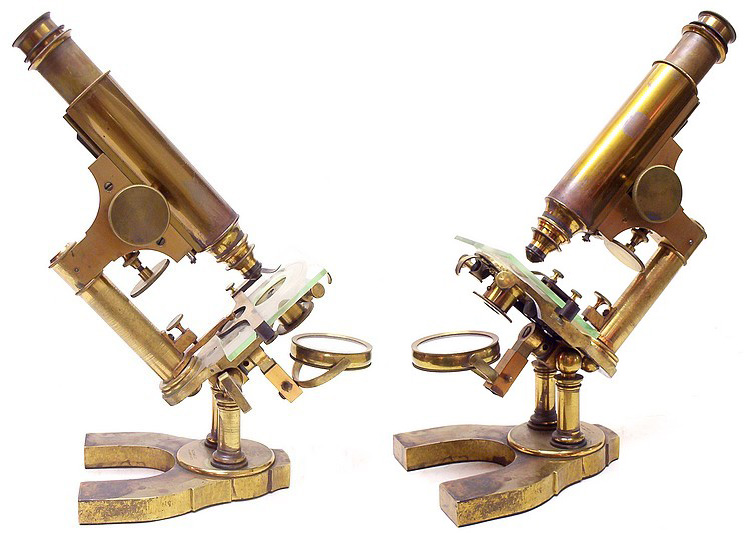
Figure 4.
A circa 1878 Wale “Continental” microscope. John Phin’s 1877 ‘Practical Hints on the Selection and Use of the Microscope’ (not coincidentally, published by Wale’s distributor), described Wale’s Continental, “Most of the stands made by the better class of French, German and Austrian microscope makers are characterized by a low, compact form, and great simplicity and solidity of construction … The general form of this stand is very similar to that of the large model of Nachet, of Paris, but the details of construction have been changed considerably, and we think for the better in many respects. The coarse movement is effected by means of a pinion and chain, the latter being kept tight by means of a spring instead of by a screw, as is the common method, and as the pinion round which the chain is wound is milled so that the links fit into it, all slip is avoided, and there is positively no ‘lost motion’ whatever - the movement responding promptly in either direction even when suddenly reversed. The fine movement consists of a lever which carries the entire body (coarse movement included) downward by means of a spring, and upward by means of a screw, the milled head of which is placed below the arm which carries the body. This brings both movements so close together that the hand may be kept on both at the same time - the thumb and fore finger operating the coarse movement, while the third and fourth fingers make the fine adjustment. A peculiarity of this microscope is found in the method by which the pillars which support the arm are attached to the foot. Instead of being screwed directly to the foot or cast on it, as is sometimes the case, they are screwed to a circular plate which rotates with a smooth and firm motion. This enables the microscopist to plane the horse-shoe either behind the stage, when the instrument is used in a horizontal or greatly inclined position, or in front of it when used in a vertical position. This confers great steadiness, with a comparatively light and convenient base. As our purpose is not to give a minute description of any of these stands, but merely to call attention to their characteristic features, we omit all mention of the very ingenious devices which Mr. Wale has introduced into its construction, such as his new form of iris diaphragm, etc.” Images adapted with permission for nonprofit, educational purposes from http://www.antique-microscopes.com/photos/George-Wale.htm
According to all official records, George Wale was born in New York City, USA, during September, 1840. Some earlier biographies of Wale suggest that he as born in England, a confusion that may be due to the birth of his cousin, microscope lens-maker William Wales, in that country. George’s parents, William and Ruth, were also émigrés from England. On the 1850 census, Father William reported that he was a pianoforte maker.
An obituary of Richard Morrison (1836-1888) states that, “Mr. Morrison formed a partnership with George Wale under the firm name of Wale & Morrison, about 1864, and they carried on together the manufacture of objectives for microscopes for some time. This partnership dissolving, Mr. Morrison returned to his former employers - Benjamin Pike's Sons”. Morrison was proficient in making lenses for microscopes and cameras before the partnership formed, having worked for the Pikes and the pioneering photographer C.C. Harrison. The fact that he partnered with Morrison suggests that Wale also had prior experience with manufacturing optics. The precedence of Wale in the company name implies that he had greater reputation and/or put up the majority of starting capital. To the best of my knowledge, no surviving items are known to have been manufactured by Wale and Morrison.
The Wale-Morrison partnership lasted for only a few years. By 1871, Wale was working in partnership with a Mr. Hawkins, as instrument-makers for the Stevens Institute of Technology in Hoboken, New Jersey. Hawkins was probably Henry Hawkins (ca. 1830 – ca. 1895), the only person with that surname who lived in the vicinity and professed to be an optician for the 1870 census.
A contemporary description indicated that Hawkins and Wale were encouraged to collaborate with the faculty and students of Stevens in development of novel technologies: “… the workshop of the instrument makers to the Institute. The Institute and the latter gentlemen - Messrs. Hawkins and Wale - are equally fortunate in effecting an arrangement such as that which, a century ago, at the University of Glasgow, resulted in the grand series of inventions of James Watt, the mathematical instrument maker to that college” (Figure 5).
In addition, Hawkins and Wale sold their creations to the public. A Hawkins and Wale microscope is illustrated in Figure 2, above. They produced a variety of other apparatus, including spectroscopes, blow-pipes for mineralogical investigations (Figure 6), a machine for measuring torsional resistance, and a novel section-cutter for preparing thin sections for mounting. Heinrich Frey thought so highly of the latter device that he included a description in his 1872 The Microscope and Microscopical Technology, adding that “the section-cutter and accessories can be obtained (to order) of Messrs. Hawkins & Wale, physical instrument makers, Stevens' Institute of Technology, Hoboken, New Jersey. Price $30, or, without the knife-frame, $20”.
Another notable invention was their College Lantern. It was described in 1871 as an attachment for magic lantern projectors designed “to throw upon a screen the images of objects which must be preserved in a horizontal position; such for example as liquids, or solids immersed in liquids. This ‘vertical lantern’ … is to be placed in front of the ordinary lantern-box, the condenser being composed of three lenses; the first two of these being of such a curve as to give, with the light about two inches from the nearer one, a practically parallel beam. This beam enters the apparatus, is received upon a mirror inclined 45°, which reflects it vertically through the third lens placed horizontally. This lens concentrates the beam upon the object glass, after passing which, it is reflected upon the screen by the silvered mirror … The apparatus was manufactured by Messrs. Hawkins & Wale of Hoboken. It is exceedingly creditable to them in the excellence of its construction and finish”. This device appears to have been very popular, and Wale prominently advertised it for many years after the partnership’s breakup (Figure 7). A different version was advertised in 1878 (Figure 8).
The Hawkins-Wale partnership ended in 1874. Wale continued working for the Stevens Institute, and retailing his products as “George Wale & Company”. If Mr. Hawkins was indeed Henry Hawkins, he moved westward. He was recorded in the 1880 US census as living in Cincinnati, Ohio, working as a book keeper. His wife was listed as a “widow” in an 1896 directory of Indianapolis, Indiana.
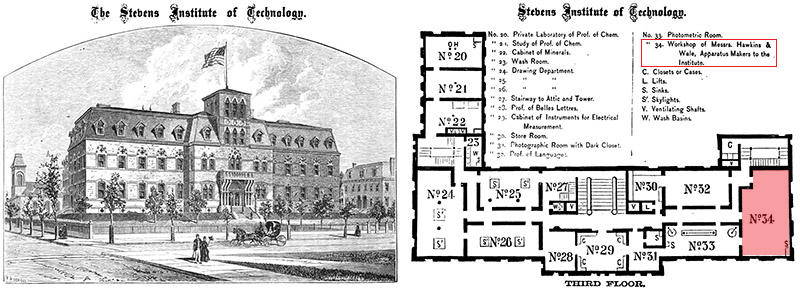
Figure 5.
Excerpts from an 1873 article on the Stevens Institute of Technology. Hawkins and Wale occupied space on the building’s top floor – the two rightmost dormer windows were theirs.

Figure 6.
An 1873 advertisement, from ‘The American Chemist’. The 1872 ‘Annual Report of the Board of Regents of the Smithsonian Institution’ stated that Hawkins and Wale supplied them with a very large variety of blowpipes.
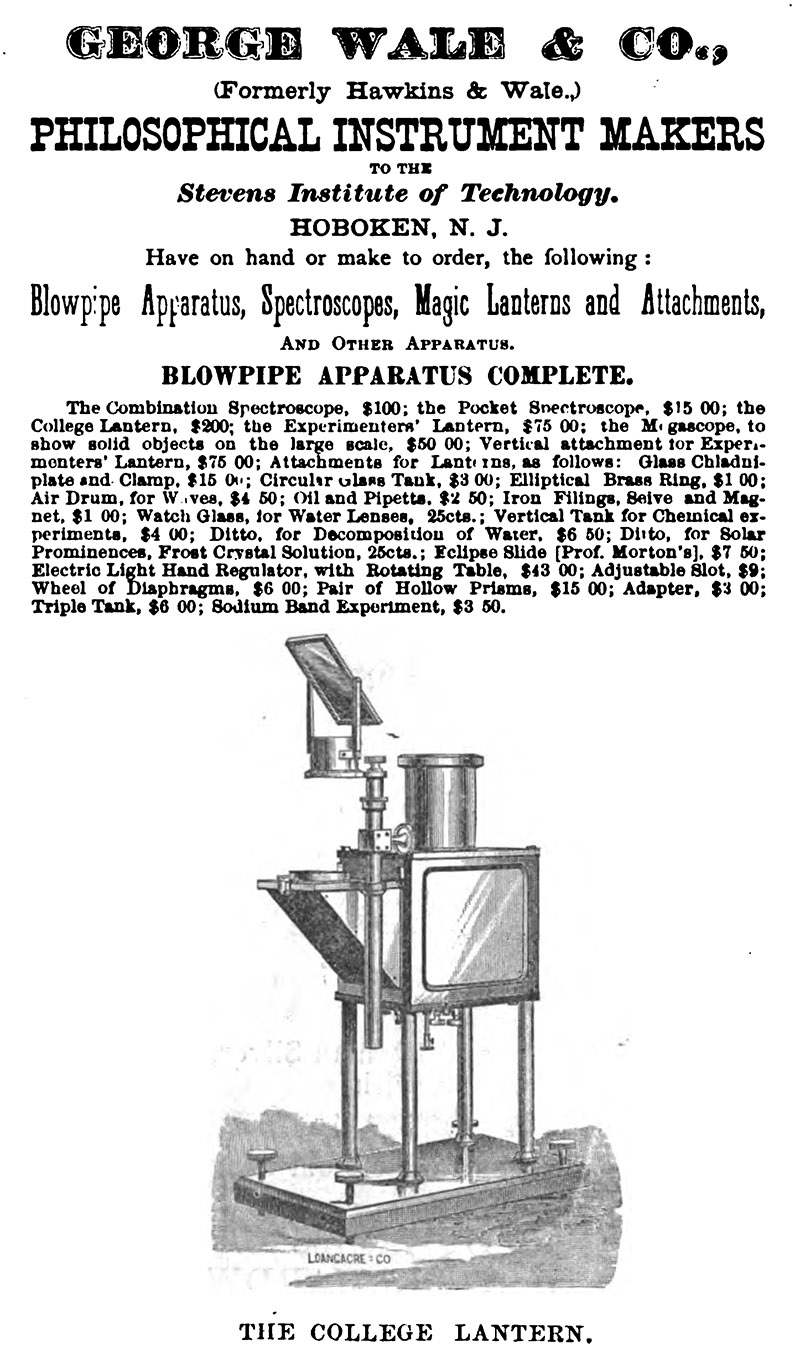
Figure 7.
An 1874 advertisement, from the Stevens Institute’s Junior Class ‘Eccentric’. Hawkins and Wale advertised together earlier in that year, indicating that the partnership dissolved during 1874.
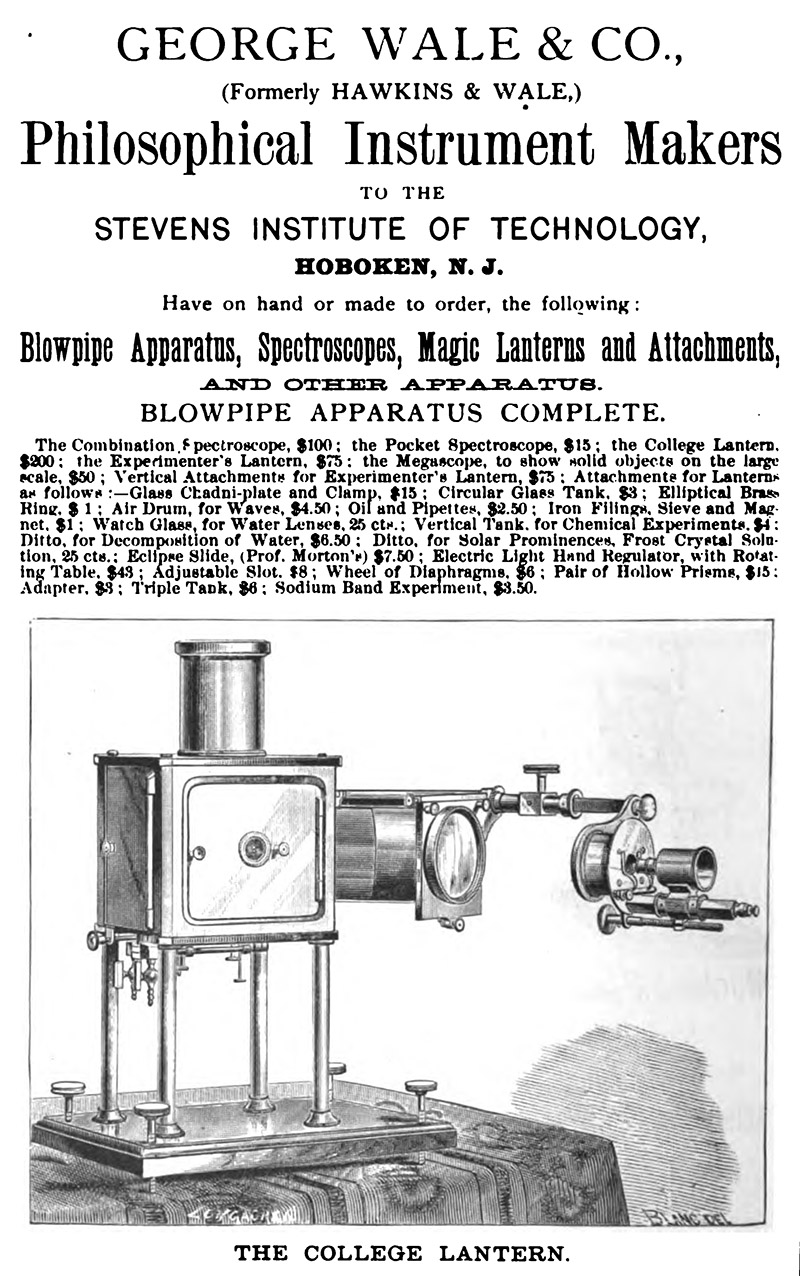
Figure 8.
An 1878 advertisement, also from the Stevens Institute “Eccentric”. The style of his College Lantern had changed dramatically since previous years.

Figure 9.
Advertisement from the 1879 ‘Eccentric’, indicating that Wale had left the Stevens Institute of Technology, and his position as school instrument-maker had passed to Samuel Hawkridge.
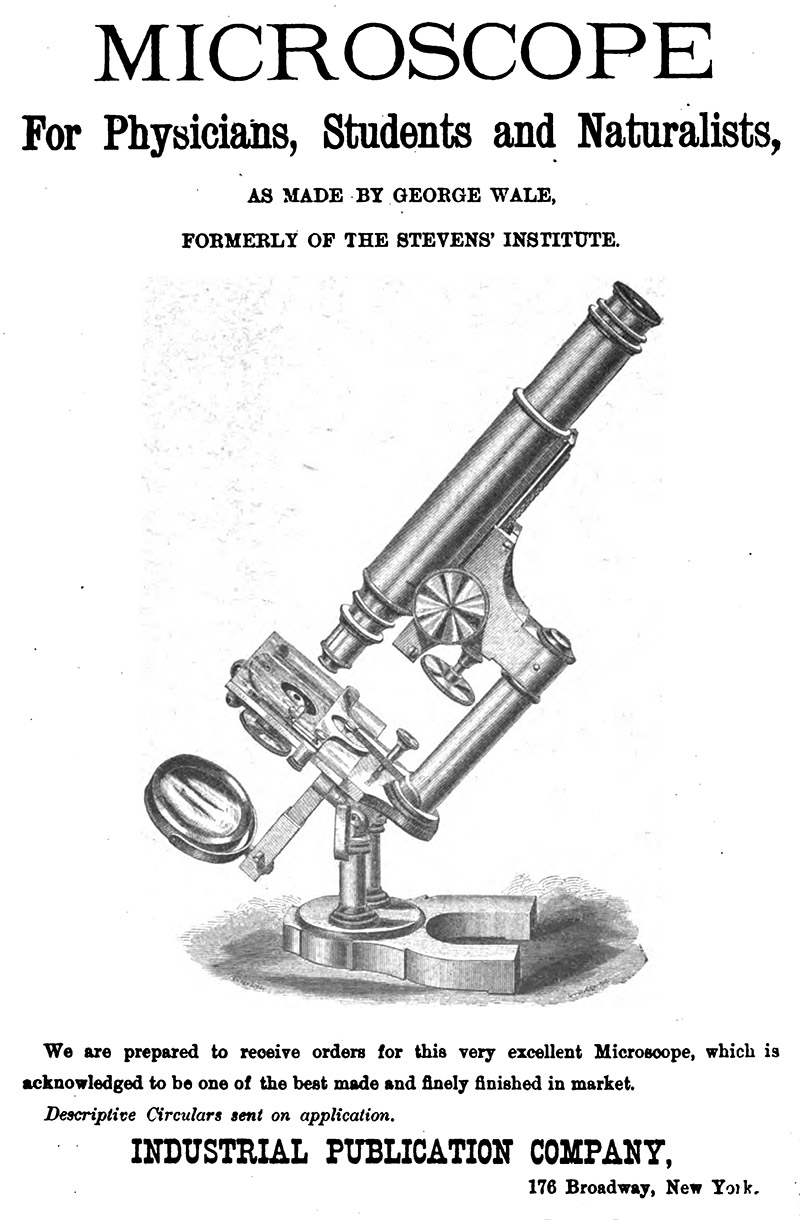
Figure 10.
An 1878 advertisement, from ‘The American Journal of Microscopy and Practical Science’. Wale then distributed his instruments through the Industrial Publication Society. The illustrated microscope is his “Continental” model.
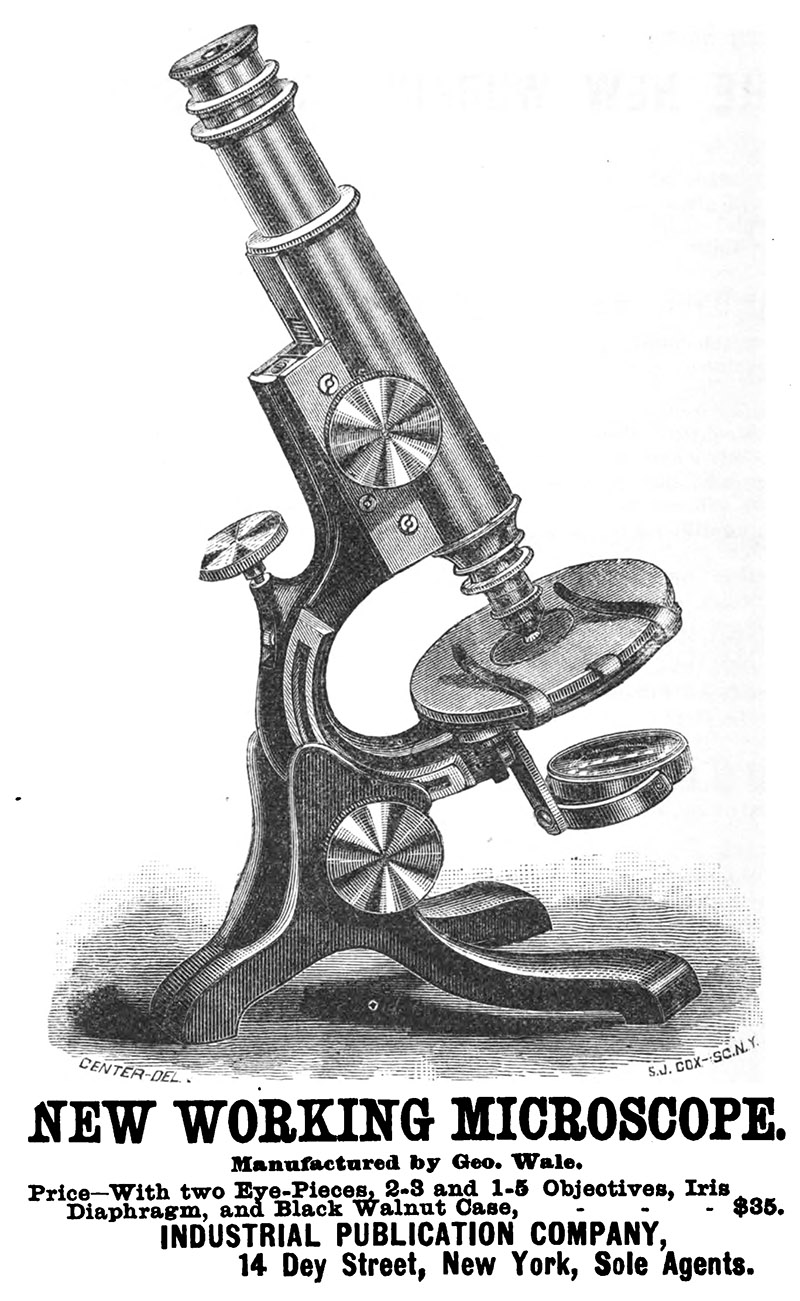
Figure 11.
An advertisement from John Phin’s 1879 “Plain Directions for the Construction and Erection of Lightning-rods”, which was published by Wale’s distributor.
George Wale severed ties with the Stevens Institute in 1878, and took on The Industrial Publication Company as his distributor. An obvious advantage to Wale is that the company regularly advertised its mechanical instruments in their books. For examples, John Phin’s 1877, second edition of Practical Hints on the Selection and Use of the Microscope included a description and engraving of Wale’s Continental microscope, and the 1881, third edition, used an engraving of Wale’s New Working microscope as the example to describe the parts of microscope. Even unrelated publications by Industrial included advertisements for Wale’s microscopes (Figure 11).
The New Working microscope created quite a stir, due to its innovative inclination mechanism and other features. It earned a Medal of Excellence at the 1880 Exhibition of the American Institute. William Carpenter made a detailed presentation on this microscope to the Royal Microscopical Society, saying that it was “one of the most practical and efficient Student’s Microscopes that he had ever seen”, and “Mr. George Wale had here developed some excellent practical ideas”. The “Wale” limb was soon employed by other microscope manufacturers, examples of which are shown at the end of this essay.
Carpenter and others also raved about Wale’s simple, effective, and inexpensive iris diaphragm (Figure 12).
There is a contemporary suggestion that Wale ceased producing microscopes around 1891. An article in The Microscope, of that year, stated, “The least expensive and the least complicated stands with which any serious work may be done, are the ‘New Working Microscope’, by Mr. George Wale … But Mr. Wale's excellent instrument has not been recently offered for sale. I fear that it has been permanently withdrawn from the market, an action much to be regretted”.
By the mid-1880s, Wale’s former partner, Richard Morrison, had become incapacitated by tuberculosis. According to Morrison’s 1888 obituary, “The management of the Morrison Works devolved upon his former partner, Mr. George Wale, who retained the same foreman, the entire plant, and since that time until the present, these lenses have been manufactured under the control of the Scovill Manufacturing Company, and by Mr. Wale and Mr. Morrison’s former associates”. Morrison manufactured photographic lenses, and it appears that Wale thereafter centered his business on producing camera lenses (Figures 16 and 17).
The American Amateur Photographer reported in 1893, “The Wale Lens is a well-known article in its way, as being quick, accurate and reliable. Mr. Wale has kindly loaned us a new lens for trial and we expect to find its quality up to the standard ... The skill of American manufacturers, in producing faultless lenses is one of the signs of advance in this line, made within the past few years. Mr. Wale has the reputation of being a careful, conscientious and painstaking lens-maker and we are glad to note that he is working in the interests of the amateur photographer”. Also that year, the secretary of the Philadelphia Photographic Society “exhibited a new rectilinear lens of the new Jena glass and iris diaphragm, made by Messrs. Wale and Lauterman, of Marksboro, N.J.” I have not located any further information on Mr. Lauterman, nor his relationship with George Wale.
Wale wrote to The American Amateur Photographer in 1894, evidently feeling slighted by recent published statements, “An Unrecorded Improvement in Photographic Lenses - Early in the year 1889 the writer constructed a lens having the elements and qualities of the recent ‘Anastigmats’. This lens was named and introduced by one of the New York stock houses. The two combinations were each made up with three lenses - a positive of heavy flint, a negative of light flint, and a positive of crown glasses. The result was, practically, an even focal plane with little or no astigmatism. As this lens was made of the ordinary kinds of optical glass, it would be reasonable to expect better results from the recently improved Jena glasses. Many of these lenses are highly prized by present owners, although they are not of the most rapid; the inevitable result or law proportionate to the number of surfaces. Marksboro, N.J., January, 1894. George Wale”.
Wale still lived in New Jersey at the time of that state’s 1895 census. He appears to have later moved to upstate New York, as an 1899 patent application for a toy kaleidoscope stated “Be it known that I, George Wale, a citizen of the United States, residing at Troy, county of Renssalaer, and State of New York”. This toy was marketed as “The Symmetroscope”, and initially sold by the Wale-Irving Company of Troy (Figure 18). Wale assigned half the patent to his partner, Frank P. Irving. The kaleidoscope was later sold by Irving alone (probably after Wale’s death), and by the American Symmetroscope Company.
Soon thereafter, the Wales moved to Everett, Massachusetts, on the outskirts of Boston. The 1900 US census recorded that George was still employed in manufacturing optical instruments. The 1902 city directory of Everett included “Wale George, optical instruments, house 100 Winslow”, while the 1904 edition had “Wale Abbie E. widow of George, h. 100 Chelsea”. The exact date of George Wale’s death has not been located.

Figure 12.
George Wale’s “Iris” diaphragm, patented on June 6, 1876. William Carpenter described it as “a most important adjunct to the Student’s Microscope”. The left diagram appeared in the January 7, 1881 issue of ‘English Mechanic and World of Science’, and was described as, “an inexpensive and very simple and ingenious form of ‘iris … It consists of a piece of very thin cylindrical tube A, about 3/4 in. in length and 5/8 in. diameter, the whole circumference of which is cut through with shears to nearly its whole length at intervals of about 1/4 in.; by means of a screw-collar B, attached below, this cut tube is forced into a parabolic metal shell (contained within C) whose apex is truncated to an aperture of about 3/8 in.; the pressure of the screw causes the thin metal tongues to turn and to overlap in a spiral which gradually diminishes the aperture to the size of a pin-hole. On unscrewing the collar B, the spiral overlapping of the tongues is released somewhat, and their elasticity causes the aperture gradually to expand. As adapted to the stage of the " Working Microscope," the iris, when unscrewed until its aperture is smallest, is then almost in contact with the base of the slide; when at its largest expansion it is about 1-16in. lower. The whole device is fitted into the opening of the stage from beneath (so as to be flush with the upper surface) with one turn of a very coarse screw on the edge of C - a far more convenient plan than the ‘bayonet joint’." A surviving Wale’s diaphragm is shown in the photographs: disassembled, and with the iris screwed in to two different depths, which results in different iris apertures.
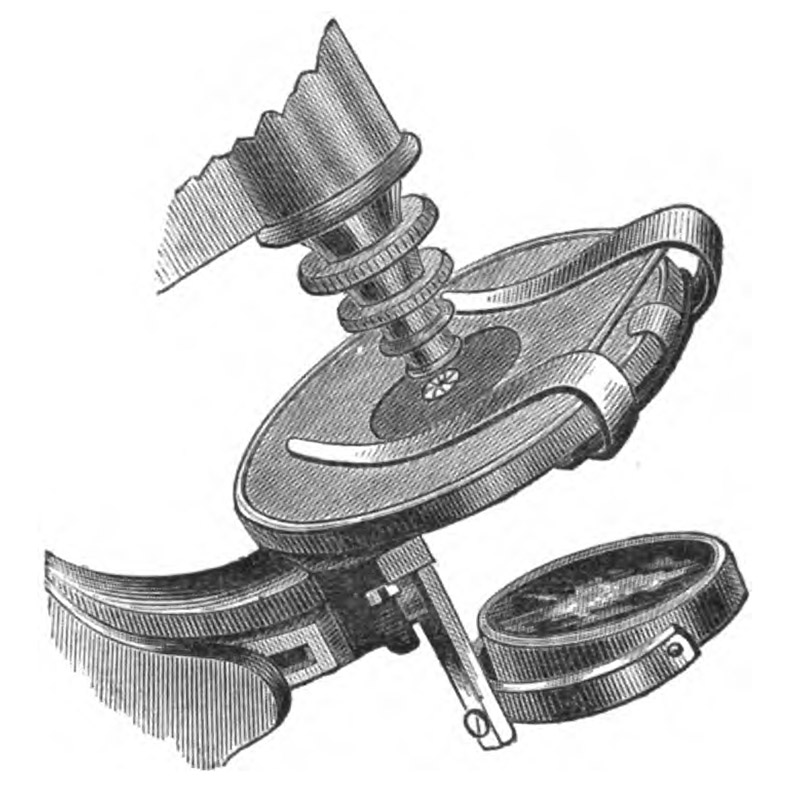
Figure 13.
George Wale’s rotating microscope clip. This was described in 1879 in the Journal of the Royal Microscopical Society and the American Journal of Microscopy, “The rotating stage, when well made, is acknowledged to be a most important and useful addition to any Microscope. It has this objection, however, that when well made it is expensive, and when badly made it is worthless. Moreover, it adds considerably to the thickness of the stage, thus interfering with the use of very oblique light. In the new Microscope of Mr. George Wale these difficulties are obviated by means of a rotating clip, shown in the annexed woodcut. In this form the stage is circular, but immovable; near the outer edge of the stage, both on the upper and the under sides, are two narrow circular grooves, in which slide two pins attached to a bar, which lies beneath the stage (as shown in the figure) and which carries the clips. To the middle of the bar is attached a spring, which keeps the frame of the clips in place on the stage. This arrangement not only allows the clips to rotate round the stage, and thus permit the object to be placed in any direction as regards the light, but it enables the microscopist to remove the clips instantly from the stage, and thus leave a clear space for work when the Microscope is used in a vertical position. The clips may also be placed on the under side of the stage, so as to hold the slide from beneath. In this way light of the utmost degree of obliquity may be used, as the stage then virtually has no thickness whatever”.
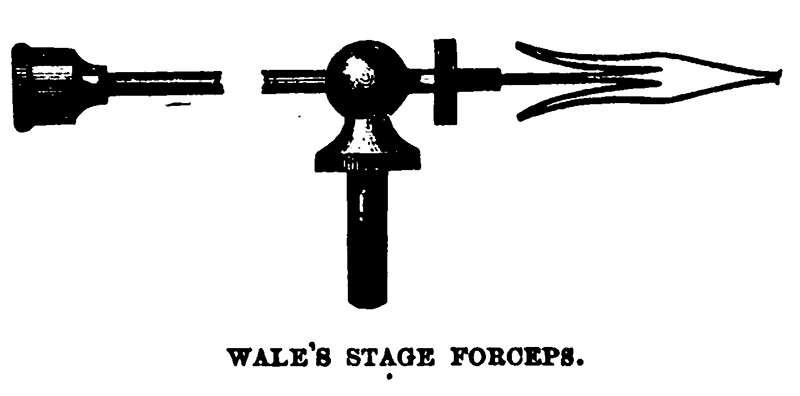
Figure 14.
��George Wale’s stage forceps, described in 1878, “The stage forceps is such a useful and convenient accessory to the microscope that any improvement whereby it is made more perfect or less costly is of value. Mr. George Wale has invented a new form of this little implement, which is shown in the accompanying cut. It will be seen that the forceps proper are made of a single piece of sheet metal bent to a shape which, though easily understood, is peculiar and very difficult to describe. Under ordinary circumstances the forceps remain closed, and take a firm grip of any object placed between their prongs, but pressing on the wing-like expansions of the metal strip forming the jaws, the latter open and the object falls out. These forceps can be made more cheaply than any others in market”.
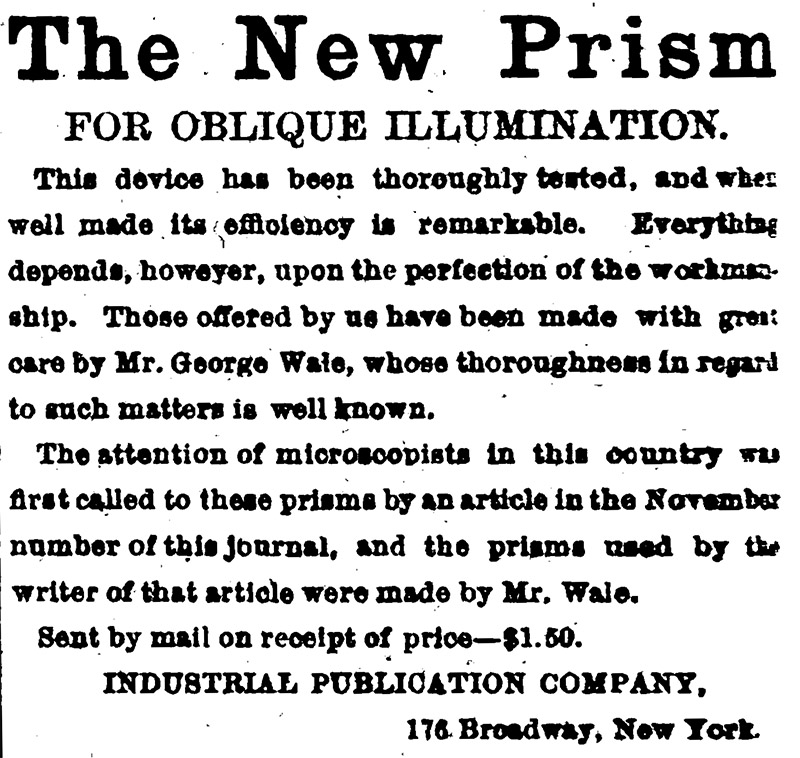
Figure 15.
An advertisement from ‘The American Journal of Microscopy’, 1881.

Figure 16.
A Wale “Universal” camera lens, mounted in a shutter that was invented by Franz J. Mathein. Advertised in 1887 by the Scovill Company, New York. Scovill acquired the tools, etc. of Richard Morrison upon his death. Adapted for nonprofit, educational purposes from http://piercevaubel.com/cam/acc/shwalemathein.htm

Figure 17.
Advertisements from 1893 (left) and 1894 (right).
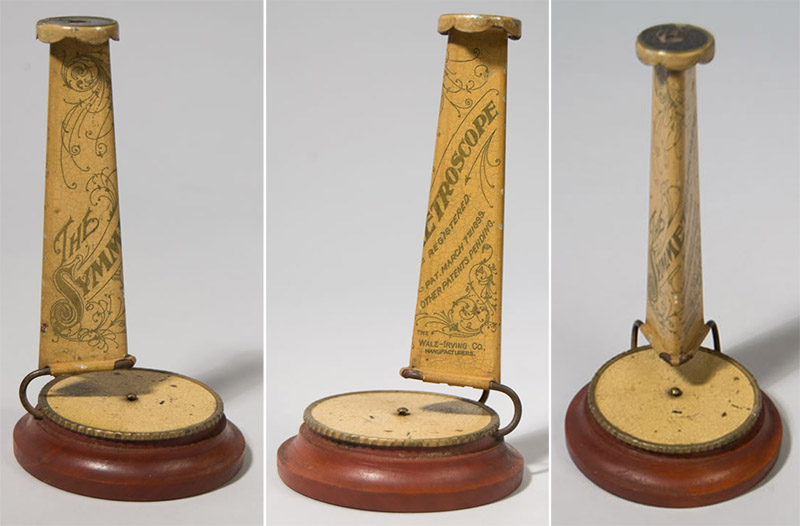
Figure 18.
A “Symmetroscope” toy kaleidoscope, produced ca. 1899 by the Wale-Irving Company. Adapted for nonprofit, educational purposes from an internet auction site.

Figure 19.
Examples of microscopes by other manufacturers, incorporating the Wale limb. Left to right: Bausch & Lomb (USA, ca. 1879), J. Swift (England, ca. 1890), J. Schrauer (USA, ca. 1880), and Bausch & Lomb (USA, ca. 1883). Images adapted for nonprofit, educational purposes. See the Resource section, below, for sources.
Acknowledgements
Many thanks to Allen Wissner for his continued support of the microscopist.net project, and for permission to use images from his collection, http://www.antique-microscopes.com
Resources
American Amateur Photographer (1893) Photographic Society of Philadelphia, Vol. 5, page 82
American Amateur Photographer (1893) Improved Wale lens, Vol. 5, page 589
American Amateur Photographer (1893) Advertisement by G. Wale, Vol. 5, page vi
American Chemist (1873) Advertisement by Hawkins and Wale, Vol. 4, page 6
American Journal of Microscopy and Practical Science (1878) Advertisement for Wale microscope, Vol. 3, October issue, page 9
American Journal of Microscopy and Practical Science (1879) Advertisements for Wale microscope and apparatus, Vol. 4, April issue, page 9
American Journal of Microscopy and Popular Science (1880) Microscopes at the Exhibition of the American Institute, Vol. 5, pages 23-24
American Journal of Microscopy and Popular Science (1880) Transactions of societies, Vol. 5, pages 268-270
American Journal of Microscopy and Popular Science (1881) Advertisement for Wale prism, Vol. 5
Ancestry.com
Annual Report of the Board of Regents of the Smithsonian Institution (1873) page 222
Annual Report of the State Geologist (1892) Water-Powers of Northern New Jersey: Marksboro, George Wale, Photographic Lenses, page 175
Davis, George E. (1889) Practical Microscopy, New and revised edition, WH Allen & Co., London, page 58
Eccentric (1874) Advertisement by George Wale & Co., page 70
Eccentric (1874) Advertisement by George Wale & Co., page 76
Eccentric (1879) Advertisement by S. Hawkridge, page 96
English Mechanic and World of Science (1881) Iris diaphragms, Vol. 32, page 415
“G.F.B.” (1871) A new attachment for the lantern, The American Journal of Science, page 71
Google Patents, inventions of George Wale (accessed January, 2016): http://www.google.com/patents/US255220, https://www.google.com/patents/US136289, https://www.google.com/patents/US178391, https://www.google.com/patents/US255220, and https://www.google.com/patents/USD30309
Frey, Heinrich (1872) The Microscope and Microscopical Technology, translated by George R. Cutter, Wm. Wood & Co., New York, pages 116-117
Hansen, James L., William A. Schrader, William R. Cowan, Joshua E. Henderson, Oscar W. Richards, Helen R. Purtle, John A. Ey (1974) The Billings Microscope Collection of the Medical Museum Armed Forces Institute of Pathology, Second edition, pages 56 and 72
Journal of the Royal Microscopical Society (1879) Rotating clips for cheap microscopes, Vol. 2, pages 623-624
The Microscope (1891) Notes on the microscope stand and some of its accessories, Vol. 11, pages 50-54
Padgitt, Donald L. (1975) A Short History of the Early American Microscopes, Microscope Publications, London and Chicago, pages 133-139
Phin, John (1879) Advertisement for Wale New Working microscope, in Plain Directions for the Construction and Erection of Lightning-rods, Industrial Publication Co., New York
Phin, John (1877) Practical Hints on the Selection and Use of the Microscope, Second edition, Industrial Publication Co., New York, pages 34-36
Phin, John (1881) Practical Hints on the Selection and Use of the Microscope, Third edition, Industrial Publication Co., New York, page 24
Photographic Times (1888) Obituary of Richard Morrison, Vol. 18, pages 578-579
Photographic Times (1888) A tribute to Richard Morrison as an optician, Vol. 18, pages 584-585
Raymond, Rossiter W. (1873) The Stevens Institute of Technology, Hoboken, New Jersey, Statistics of Mines and Mining in the States and Territories West of the Rocky Mountains, Government Printing Office, Washington, pages 475-479
Scovill Manufacturing Company (1887) How to Make Photographs and Descriptive Price List, p. 50, accessed through http://piercevaubel.com/cam/acc/shwalemathein.htm
Sellers, Coleman, and Albert R. Leeds (1892) Biographical Notice of President Henry Morton, Ph.D. of the Stevens Institute, Engineering Press, New York, pages 104-105
Smith, James E. (1880) How to See with the Microscope, Duncan Bros., Chicago, page 342
Thurston, R.H. (1873) Torsional resistance of materials determined by a new apparatus with automatic registry, Journal of the Franklin Institute, Vol. 95, pages 254-260
Unity (1894) Advertisement by G. Wale, Vol. 31, page 320
Van Nostrand's Engineering Magazine (1872) Stevens Institute of Technology, Vol. 5, pages 531-536
Wale, George (1894) An unrecorded improvement in photographic lenses, American Amateur Photographer, Vol. 6, page 98
Ward, R.H. (1876) Microscopy at the American Exhibition, The Monthly Microscopical Journal, Vol. 17, pages 25-30
Young Scientist (1878) Stage forceps, Vol. 1, page 108
Images of microscopes and other instruments:
Hawkins and Wale microscope (graphic only): http://micro.magnet.fsu.edu/primer/museum/hawkinswale.html
Wale ca. 1876 microscope: http://www.microscope-antiques.com/waleprizemicro.html and https://digital.lib.ecu.edu/22088
Wale “Continental” microscope: http://www.antique-microscopes.com/photos/George-Wale.htm
Wale “New Working” microscope: http://www.microscope-antiques.com/waleslimb.html, http://www.antique-microscopes.com/photos/George_Wale_Working_microscope.htm, and http://arsmachina.com/wale1235.htm
Wale photographic lens: http://piercevaubel.com/cam/acc/shwalemathein.htm
Bausch & Lomb “New Student” microscope: http://www.antique-microscopes.com/photos/BL_wale.htm
Bausch & Lomb “American Concentric” microscope: https://digital.lib.ecu.edu/22080
Schrauer Wale limb microscope: http://www.antique-microscopes.com/photos/schrauer-wale_limb.htm
Swift ca. 1890 Wale limb microscope: http://www.microscope-antiques.com/swiftwales.html and http://www.arsmachina.com/s-swiftwale1498.htm
Swift ca. 1925 Wale limb microscope: http://www.microscope-antiques.com/swiftsymp.html
Wale-Irving Symmetroscopes: http://www.thekaleidoscopebook.com/thescopebook/kaleidoscopes/top-25-toy-scopes/top-25-toy-scopes-the-scopes/46-2-symmetroscope, and https://www.knottypineantiques.com/events/auctions_events_details.asp?AuctionID=84&LotNum=220#


















